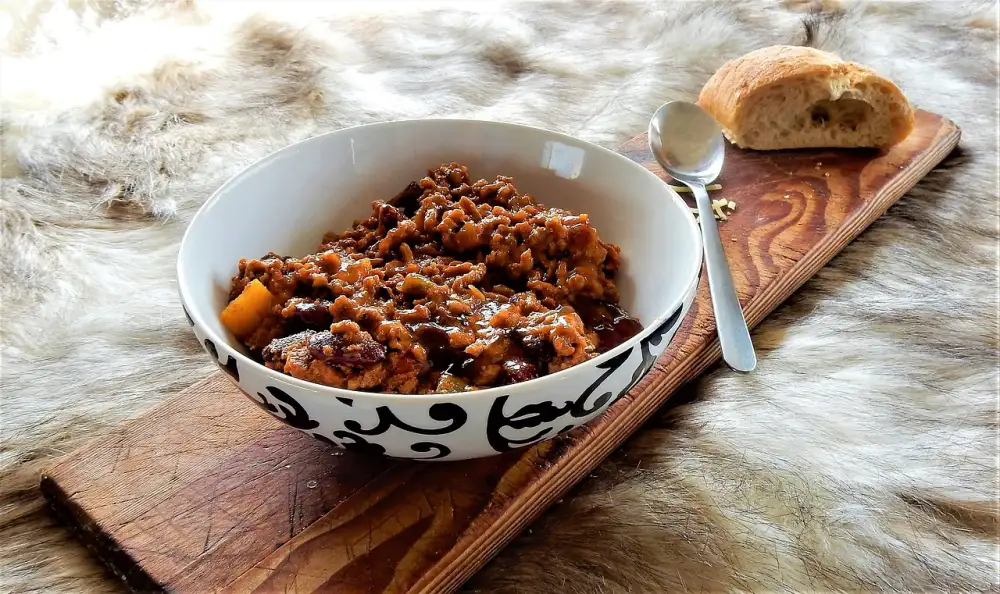Spice up Your Taste Buds with Irresistible Chili Con Carne: A Fiery Delight for Food Enthusiasts

- History and origins of chili con carne
- Key ingredients of chili con carne: chili peppers, meat, tomatoes, and beans
- Variations of chili con carne: regional and cultural adaptations
- Cooking methods and techniques for preparing chili con carne
- Serving suggestions and popular accompaniments for chili con carne
- Health benefits of chili con carne: rich in protein and vitamins
- Tips for making the perfect chili con carne at home
- Frequently asked questions about chili con carne
Chili con carne, a flavorful and spicy stew, is a beloved dish that has captured the hearts and taste buds of food enthusiasts around the world. This fiery delight is known for its rich blend of flavors and tantalizing aroma. Whether you're a fan of spicy food or simply looking to explore new culinary experiences, chili con carne is sure to satisfy your cravings. Get ready to embark on a journey through the world of irresistible flavors as we dive into the history, ingredients, variations, cooking methods, health benefits, and tips for making the perfect chili con carne at home.
History and origins of chili con carne
Chili con carne, a flavorful and spicy stew, has a rich history and fascinating origins. It is believed to have originated in the 17th century in the region that is now known as Texas, United States. The dish was popularized by Mexican immigrants who settled in the area. They brought with them their love for chili peppers and combined it with local ingredients such as meat and tomatoes. Over time, chili con carne spread across the United States and became a beloved dish in many households. Its popularity grew even further with the advent of canned chili in the early 20th century. Today, chili con carne is enjoyed worldwide, with each region adding its own unique twist to this classic dish.
Key ingredients of chili con carne: chili peppers, meat, tomatoes, and beans
The key ingredients of chili con carne are chili peppers, meat, tomatoes, and beans. Chili peppers are the star of the dish, providing the fiery heat and distinct flavor. Different varieties like jalapeno, habanero, or ancho can be used to achieve varying levels of spiciness. The meat component is typically beef, although pork or chicken can also be used. The tomatoes add a tangy sweetness and help to balance out the spice. Lastly, beans such as kidney beans or black beans give the dish a hearty texture and provide additional protein and fiber. These ingredients work together harmoniously to create a delicious and satisfying bowl of chili con carne.
Variations of chili con carne: regional and cultural adaptations
Chili con carne is a dish that has been embraced and adapted by various regions and cultures around the world. From its origins in Texas, where it was traditionally made with beef and chili peppers, to the countless variations found in different countries, chili con carne has become a global culinary phenomenon.
In Mexico, for example, chili con carne is often made with chunks of pork or chicken instead of beef. The addition of spices like cumin and oregano gives it a distinct Mexican flavor. In the Caribbean, chili con carne takes on a tropical twist with the inclusion of ingredients like coconut milk and plantains.
In South America, countries like Argentina and Brazil have their own versions of chili con carne. In Argentina, it is known as "carne con chile" and is typically made with ground beef and a variety of vegetables. In Brazil, feijoada is a popular dish that features black beans and various cuts of meat cooked together with chili peppers.
Even within the United States, there are regional adaptations of chili con carne. In Cincinnati, Ohio, for instance, they have their own unique take on this classic dish called "Cincinnati-style chili." It is typically served over spaghetti noodles and topped with shredded cheese and onions.
These regional and cultural adaptations showcase the versatility of chili con carne as a dish that can be customized to suit different tastes and preferences. Whether you prefer it spicy or mild, with beef or chicken, there's no shortage of options when it comes to enjoying this fiery delight.
Cooking methods and techniques for preparing chili con carne
Cooking methods and techniques for preparing chili con carne vary, but the key is to develop layers of flavor. Start by browning the meat in a hot pan to enhance its taste. Then, sauté onions, garlic, and spices like cumin and paprika to release their aromas. Add chili peppers, tomatoes, and beans along with broth or water. Simmer on low heat for at least an hour to allow the flavors to meld together. For a thicker consistency, use a slow cooker or let it simmer uncovered. Adjust seasoning as needed and serve hot with your favorite toppings.
Serving suggestions and popular accompaniments for chili con carne
When it comes to serving chili con carne, there are numerous options to enhance its flavors and create a satisfying meal. One classic way to enjoy this fiery stew is by ladling it over a bed of fluffy white rice. The heat from the chili peppers and the richness of the meat blend perfectly with the neutral taste of rice.
For those looking for a heartier option, serving chili con carne with warm cornbread is a popular choice. The sweet and crumbly texture of cornbread complements the spiciness of the dish, creating a delightful contrast.
If you prefer something lighter, topping your chili con carne with a dollop of sour cream or Greek yogurt can help balance out the heat. The coolness of these dairy products adds a creamy element that soothes your taste buds.
For added crunch and freshness, consider garnishing your chili con carne with chopped onions, cilantro, or sliced jalapeños. These toppings not only add vibrant colors but also provide additional layers of flavor to each spoonful.
Lastly, don't forget about the cheese! Sprinkling some grated cheddar or Monterey Jack cheese on top of your chili con carne adds richness and creaminess that pairs wonderfully with the spicy stew.
Whether you choose to serve it over rice, with cornbread, or topped with various garnishes, chili con carne is a versatile dish that can be enjoyed in countless ways. Experimenting with different accompaniments allows you to personalize your meal and discover new flavor combinations that will keep you coming back for more.
Health benefits of chili con carne: rich in protein and vitamins
Chili con carne is not only a delicious and fiery dish, but it also offers numerous health benefits. Packed with protein from the meat and beans, it provides essential amino acids for muscle growth and repair. Additionally, chili peppers are rich in vitamins A and C, which boost the immune system and promote healthy skin. The tomatoes in chili con carne are a great source of lycopene, an antioxidant that may reduce the risk of certain cancers. So, indulge in this flavorful stew guilt-free as it nourishes your body with its protein-packed goodness and vitamin-rich ingredients.
Tips for making the perfect chili con carne at home
1. Choose the right meat: Opt for lean cuts like ground beef or turkey, as they add flavor without excess fat.
2. Spice it up: Experiment with different types of chili peppers to find your preferred level of heat. Add spices like cumin, paprika, and oregano for an extra kick.
3. Don't forget the beans: While some traditional recipes omit beans, adding kidney or black beans can enhance both texture and taste.
4. Simmer slowly: Allow your chili to cook on low heat for a longer duration to allow flavors to meld together and develop a rich depth.
5. Taste as you go: Adjust seasoning and spice levels throughout the cooking process to ensure a well-balanced flavor profile.
6. Let it rest: After cooking, let your chili sit for a while before serving. This will allow the flavors to further intensify and meld together.
7. Serve with toppings: Offer a variety of toppings such as shredded cheese, sour cream, diced onions, or fresh cilantro to customize each bowl of chili.
By following these tips, you'll be able to create a mouthwatering bowl of chili con carne that will impress your friends and family!
Frequently asked questions about chili con carne
1. Is chili con carne always spicy?
No, the level of spiciness can be adjusted according to personal preference. You can use milder chili peppers or reduce the amount of spice for a milder version.
2. Can I make chili con carne without beans?
Absolutely! While beans are a traditional ingredient, you can omit them if you prefer. This allows you to customize your chili to suit your taste and dietary preferences.
3. Can I substitute the meat in chili con carne?
Yes, you can experiment with different types of meat such as ground beef, chicken, turkey, or even vegetarian options like tofu or tempeh. Each variation will bring its own unique flavor profile.
4. How long does it take to cook chili con carne?
The cooking time can vary depending on the recipe and method used. On average, it takes around 1-2 hours for the flavors to develop and the meat to become tender.
5. Can I freeze leftover chili con carne?
Yes, chili con carne freezes well and can be stored for up to 3 months in an airtight container. Simply thaw and reheat when ready to enjoy again.
6. What are some popular toppings for chili con carne?
Popular toppings include shredded cheese, sour cream, diced onions, chopped cilantro, jalapenos, and sliced avocado. These add extra texture and flavor to your bowl of chili.
7. Is chili con carne a complete meal on its own?
Yes! Chili con carne is packed with protein from the meat and beans, making it a satisfying meal on its own. However, you can also serve it with rice or cornbread for a heartier option.
8. Can I make vegetarian or vegan chili con carne?
Definitely! There are numerous recipes available that use plant-based proteins like beans or tofu instead of meat. These versions still offer delicious flavors and a hearty texture.
Remember, these are just some common questions about chili con carne. Feel free to experiment and adapt the recipe to suit your taste preferences and dietary needs.
In conclusion, chili con carne is a dish that offers a world of delicious possibilities. Its flavorful and spicy nature makes it a favorite among food enthusiasts. With its rich history and origins, this stew has evolved into various regional and cultural adaptations, each offering unique flavors and ingredients.
Whether you prefer it with beef, pork, or even vegetarian options, chili con carne can be customized to suit your taste buds. The combination of chili peppers, meat, tomatoes, and beans creates a harmonious blend of flavors that is both satisfying and comforting.
When it comes to cooking methods and techniques, there are numerous ways to prepare chili con carne - from slow-cooking for hours to pressure cooking for a quick meal. The choice is yours!
To enhance the experience of enjoying chili con carne, consider serving it with popular accompaniments such as rice, cornbread, or tortilla chips. These additions complement the stew's robust flavors perfectly.
Not only does chili con carne satisfy your taste buds, but it also offers health benefits. Packed with protein and vitamins from the meat and vegetables used in its preparation, this dish can be a nutritious addition to your diet.
To make the perfect chili con carne at home, follow some simple tips like using quality ingredients, adjusting the spice level to your preference, and allowing enough time for the flavors to meld together.
If you have any questions about chili con carne - its history, ingredients or cooking techniques - refer to our frequently asked questions section for more information.
So why not embark on a culinary adventure and explore the diverse flavors of chili con carne? From traditional Tex-Mex versions to unique twists from around the world, there is something for everyone to enjoy in this fiery delight!
Published: 21. 11. 2023
Category: Food



